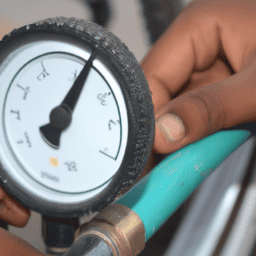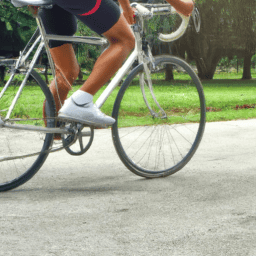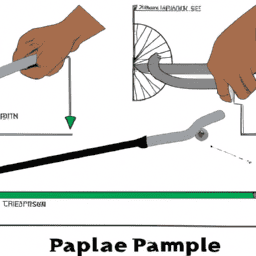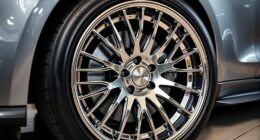Hello fellow cyclists! Are you exhausted from the sensation that you’re cycling through sludge? Perhaps it’s time to inflate those tires with some air!
In this article, I’ll be walking you through the process of inflating your bicycle tire like a pro. Whether you’re a seasoned rider or just starting out, it’s important to know how to properly inflate your tire for a smoother, safer ride.
First things first, let’s gather the necessary tools. You’ll need a bicycle pump, a tire gauge, and of course, your trusty bike. Don’t have a pump or a gauge? No worries, you can easily purchase them at your local bike shop or online.
Once you have your tools, it’s time to prepare your tire for inflation. Follow these steps and you’ll be back on the road in no time!
Key Takeaways
- Proper tire inflation is crucial for a smooth and safe bike ride, and affects performance and reduces the risk of a flat tire.
- Necessary tools for inflating bicycle tires include a pump, a tire gauge, and the bike itself, and regular pump maintenance is important.
- Valve caps play an important role in maintaining tire pressure by preventing dust, dirt, and debris from causing leaks, and choosing a snug-fit cap with a built-in seal is important.
- Checking tire pressure regularly with a gauge is crucial to prevent underinflation or overinflation, and relying on the appearance of the tire to determine pressure is a common mistake. A digital tire gauge can provide an accurate and easy-to-read display.
Gather the Necessary Tools
Got a flat tire on your bike? Don’t worry, let’s grab the tools you need to pump it up! Proper inflation is important for a smooth and safe ride.
The first tool you need is a pump. There are a variety of pumps available, but the most common ones are hand pumps or floor pumps. Hand pumps are portable and can be carried with you on your ride, while floor pumps are more stable and provide more power for quick inflation.
Choosing the right pump depends on your specific needs. If you ride frequently, a floor pump is more suitable, as it can inflate your tire quickly, and has a stable base to support the pump. On the other hand, a hand pump is perfect for emergency situations or when you’re on the go. It’s small, lightweight, and easy to carry.
With these tools in hand, you’re ready to prepare your tire for inflation.
Prepare Your Tire for Inflation
Before inflating my bicycle tire, I always remove the valve cap to expose the valve stem. This allows me to attach the pump nozzle securely to the valve stem.
Next, I check the tire pressure using a pressure gauge to ensure that it’s within the recommended range. This step is crucial to prevent overinflating or underinflating the tire, which can affect the ride quality and safety.
Remove the Valve Cap
First, grab a coin or small tool to gently unscrew the valve cap, just like opening a treasure chest to reveal your smooth-rolling ride.
Valve caps play an important role in keeping your tire valve clean and free from debris, as well as maintaining proper tire pressure by preventing air from escaping.
There are different types of valve caps available in the market, including those with built-in pressure indicators, lockable ones, and even decorative ones.
When not in use, it’s best to store valve caps in a cool and dry place to avoid rust or damage.
To remove the valve cap, hold the tire valve steady with one hand and use the other to unscrew the cap counterclockwise. Be careful not to apply too much force as it may damage the valve stem.
Once the cap is removed, set it aside in a safe place where it won’t get lost. In case you accidentally lose the valve cap, replace it with a new one as soon as possible to avoid dirt and moisture from entering the valve.
With the valve cap removed, it’s time to move on to the next step checking the tire pressure.
Check the Tire Pressure
Now it’s time to see if your tire pressure is up to par by using a tire pressure gauge. Checking the tire pressure is an important step before inflating the tire. It ensures that you’re adding the correct amount of air to the tire, which’ll improve the bike’s performance and lifespan.
The importance of proper tire pressure can’t be overstated. Low tire pressure can cause a range of issues, including reduced speed, increased effort needed to ride, and decreased control over the bike. Additionally, it can increase the likelihood of getting a flat tire.
Maintaining the correct tire pressure is crucial for a smooth and safe ride. With that being said, let’s move on to the next step and learn how to inflate the tire.
Inflate the Tire
First, I attach the pump to the valve by unscrewing the valve cap and pressing the pump head onto the valve stem. I make sure the pump head is securely attached to prevent any air leakage.
Next, I pump air into the tire by using a consistent and steady motion until the desired pressure is reached. I check the tire pressure with a gauge and adjust as needed.
Finally, I monitor the tire pressure regularly to ensure proper inflation and avoid any potential issues while riding.
Attach the Pump to the Valve
To attach the pump to the valve, you’ll need to make sure the nozzle fits securely onto the valve stem. Proper alignment is crucial to ensure a tight seal and prevent air from leaking out.
There are different valve types, such as Presta and Schrader valves, so make sure you have the correct pump attachment for your valve type.
To attach the pump, first unscrew the valve cap and press the nozzle onto the valve stem. Make sure the nozzle is straight and aligned with the valve stem, then clamp it down securely.
You can now begin pumping air into the tire, but make sure to keep an eye on the pressure gauge and stop when the desired pressure is reached. With the pump properly attached, inflating your bicycle tire should be a breeze.
Pump Air into the Tire
You’ll want to pay close attention to the pressure gauge as you use the pump attachment to properly inflate your tire and ensure a smooth ride.
First, make sure that the pump is securely attached to the valve. Then, start pumping air into the tire by pushing down on the handle or lever of the pump.
It’s important to note that different types of tire pumps may require different techniques for inflating the tire. For example, some pumps may require you to use a foot pedal to pump air into the tire, while others may require you to manually pump air into the tire.
Additionally, it’s important to regularly check pump maintenance to ensure that it’s in good working condition and able to properly inflate your tire.
With the tire properly inflated, you can now move on to monitoring the tire pressure to ensure that it stays within the recommended range for your bike.
Monitor the Tire Pressure
Make sure you regularly check the tire pressure to ensure a safe and smooth ride on your bike. The importance of proper tire pressure cannot be overstated. If your tire pressure is too low, it can make your bike difficult to handle, increase the risk of a flat tire, and even cause premature wear on your tires. On the other hand, if your tire pressure is too high, it can make your bike feel harsh to ride and decrease your traction on the road.
To monitor your tire pressure, you will need a tire pressure gauge. This tool will allow you to measure the pressure inside your tire and make sure it is within the recommended range. It is important to note that tire pressure can change with temperature, so it is best to check your tire pressure when your bike is cool and hasn’t been ridden for a while. One common mistake when monitoring tire pressure is not checking it often enough. It is recommended to check your tire pressure at least once a week, but even more frequently if you ride your bike on a regular basis. Another mistake is relying on the appearance of the tire to determine the pressure. The only way to know for sure is to use a tire pressure gauge.
Now that you know the importance of proper tire pressure and how to monitor it, it’s time to finish up and hit the road.
Finish Up
Now that I’ve finished inflating my bicycle tire, it’s important to disconnect the pump from the valve stem.
To do this, I’ll need to unscrew the lever or twist the nozzle counterclockwise. It’s crucial to do this carefully to avoid damaging the valve stem or causing a sudden release of air.
Once the pump is disconnected, I should replace the valve cap to protect the valve from dirt and debris.
Disconnect the Pump
First, take a firm grip on the valve stem and gently loosen the pump head from the valve by pulling it straight off. This step is crucial as it prevents any air from escaping from the tire.
Once you’ve removed the pump head, you can now disconnect the pump from the tire. Be sure to hold onto the pump head as you remove it to avoid damage to the valve stem.
Reconnecting the pump can sometimes be tricky, especially if you encounter any common pump issues such as a leaky seal or difficulty getting the pump head to lock onto the valve properly. If you experience any issues, check the pump manual for troubleshooting tips or seek assistance from a professional.
Once you have successfully disconnected the pump, the next step is to replace the valve cap to ensure that your tire stays inflated.
Replace the Valve Cap
Don’t forget to pop the valve cap back onto the stem like putting the cherry on top of a sundae, to keep your tire from losing pressure.
Valve caps may seem like a small and insignificant part of your bike, but they play an important role in maintaining tire pressure. Valve caps prevent dust, dirt, and other debris from entering the valve stem and causing leaks. It’s important to use valve caps to protect your tire’s longevity and performance.
When choosing a valve cap, look for one that fits snugly onto your valve stem and has a built-in seal to prevent leaks. Additionally, valve caps come in a variety of materials such as plastic, metal, and aluminum. Depending on your lifestyle, you may want to choose a valve cap that is durable and long-lasting.
Now that you’ve replaced the valve cap, it’s time to focus on maintaining proper tire pressure.
Tips for Maintaining Proper Tire Pressure
As a cyclist, I know the importance of maintaining proper tire pressure. To keep my bike functioning smoothly, I check my tire pressure regularly.
Overinflating your tires can lead to a bumpy ride and even cause damage to the tire, so it’s important to avoid this. To ensure I’m getting an accurate reading, I’ve invested in a tire gauge.
By following these tips, I can keep my tires at the right pressure for a safe and enjoyable ride.
Check Your Tire Pressure Regularly
Make sure you regularly check the pressure of your bicycle tires to ensure optimal performance and reduce the risk of a flat tire. Maintaining proper tire pressure is crucial because low pressure can cause the tire to wear out quickly and become more susceptible to punctures.
On the other hand, overinflating the tire can lead to a bumpy and uncomfortable ride, and increase the chances of a blowout. The consequences of low or high tire pressure can also affect your bike’s handling and braking ability.
Riding with underinflated tires can make it harder to steer and control your bike, especially when cornering or going downhill. Additionally, it increases the rolling resistance, which means you need to pedal harder and use more energy to keep up the same speed.
Overinflated tires, on the other hand, can reduce the amount of contact the tire has with the ground, which in turn reduces traction and grip, making it harder to brake effectively. Therefore, it’s essential to check your tire pressure regularly to ensure that it’s within the recommended range and adjust accordingly.
Avoid overinflating your tires to prevent unnecessary wear and increase your risk of getting a flat tire.
Avoid Overinflating Your Tires
It’s crucial to maintain the recommended tire pressure to ensure safe and smooth rides. The importance of proper tire pressure cannot be overstated, as it directly affects your bike’s performance.
Overinflated tires, for instance, can reduce traction and grip, which can lead to a 30% increase in stopping distance. On the other hand, underinflated tires can cause your bike to handle poorly, making it difficult to turn and maneuver.
Dangers of overinflating tires include reduced contact patch size, which means less rubber on the road and less grip. This can lead to skidding, especially on wet or slippery surfaces. Overinflated tires also increase the risk of blowouts, as they are more susceptible to punctures and damage from impacts.
Hence, it’s essential to keep your tire pressure within the recommended range, which is usually indicated on the sidewall of the tire. Consider investing in a tire gauge to check your tire pressure regularly.
Consider Investing in a Tire Gauge
Investing in a tire gauge is a simple yet effective way to ensure that your bike’s tires are always at the recommended pressure. Not only will it save you money on frequent replacements, but it will also provide a safer and more comfortable ride.
There are various types of tire gauges available in the market, and choosing the right one for your bike is crucial. One of the benefits of investing in a tire gauge is that it allows you to measure your tire pressure accurately. It gives you a precise reading of the air pressure in your tires, allowing you to inflate or deflate them as necessary. This helps prevent overinflation or underinflation, which can cause damage to your tires and affect your bike’s performance.
However, it’s important to note that some tire gauges may not be as accurate as others, so it’s crucial to choose one that is reliable and trustworthy. Consider investing in a digital tire gauge that provides a clear and easy-to-read display.
When choosing the right tire gauge for your bike, there are several factors to consider. First, consider the type of valve your bike has: Presta or Schrader. You’ll need to choose a gauge that’s compatible with your valve type. Then, consider the accuracy and reliability of the gauge. Look for one that’s well-reviewed and has a reputation for being accurate. Finally, consider the design and ease of use. Choose a gauge that’s easy to handle and read, with a comfortable grip.
Investing in a tire gauge is a small investment that can make a big difference in your bike’s performance and lifespan.
Frequently Asked Questions
How often should I check my bike tire pressure?
Checking my bike tire pressure regularly is crucial for optimal performance. Weather conditions affect tire pressure, so I adjust accordingly. It’s a technical process, but it’s precise and necessary for a smooth ride.
Can I use a regular air pump to inflate my bike tire?
Yes, I can use a regular hand or foot pump to inflate my bike tire. However, I must ensure that the pump has the correct valve head for my tire and that I reach the recommended PSI for optimal performance.
What should I do if my bike tire keeps losing air?
Dealing with a constantly deflating bike tire can be as frustrating as trying to fill a balloon with a hole. Possible solutions include puncture prevention and regular tire maintenance to ensure proper inflation and avoid leaks.
What is the recommended tire pressure for different types of bikes?
Proper tire pressure is crucial for optimal bike performance. Factors affecting tire pressure include rider weight, terrain, and tire type. Consult your bike manual or a professional for recommended pressure for your specific bike and riding conditions.
Can I over-inflate my bike tire?
Over-inflating my bike tire can lead to potential dangers such as blowouts or loss of control. It’s important to always check and maintain correct inflation levels to ensure safe and efficient riding.
Conclusion
Well, there you have it, folks! Inflating your bicycle tire isn’t as daunting as it may seem. With the right tools and a little bit of knowledge, you can easily pump air into your tire and be back on the road in no time.
But don’t forget, maintaining proper tire pressure is key to ensuring a smooth and safe ride. So, make it a habit to check your tire pressure regularly and adjust it accordingly. Trust me, the difference in performance and comfort is like night and day!
In fact, I’d go as far as to say that proper tire pressure is the holy grail of cycling. It can make all the difference in your ride, taking you from feeling like you’re pedaling through quicksand to gliding effortlessly on the road.
So, go forth and inflate those tires with confidence, my fellow cyclists!









